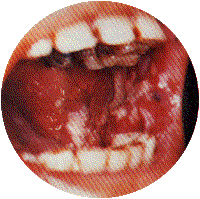Smokeless Tobacco: Health and Other Effects

Smokeless tobacco is addictive! -- Smokeless tobacco contains nicotine, the same drug that makes cigarettes addictive. If you hold an average size dip or chew in your mouth for 30 minutes, you get as much nicotine as you do from about 3 cigarettes.8 It is so addicting that some smokeless tobacco users sleep with it in their mouths so they keep getting nicotine through the night.
Smokeless tobacco causes health problems -- Smokeless tobacco can cause permanent gum recession, mouth sores, precancerous lesions in the mouth, and cancers of the mouth and throat.
 Gum recession (when the gums fall away from the teeth) - Gum recession is not only unsightly, but can increase your risk of cavities on tooth roots and make your teeth sensitive. Gum recession is difficult to repair Gum recession (when the gums fall away from the teeth) - Gum recession is not only unsightly, but can increase your risk of cavities on tooth roots and make your teeth sensitive. Gum recession is difficult to repair Sores, white patches, red patches, and lumps inside your mouth are signs of damage caused by chewing and dipping. Changes inside your mouth (oral mucosa) can be seen microscopically as soon as seven days after starting to use smokeless tobacco. White patches, also called leukoplakias (loo-ko-play-kee-uhs), can turn into cancer over time. Red patches, also called erythroplakias (eth-row-play-kee-uhs) have a high potential to become cancerous. Sores, white patches, red patches, and lumps inside your mouth are signs of damage caused by chewing and dipping. Changes inside your mouth (oral mucosa) can be seen microscopically as soon as seven days after starting to use smokeless tobacco. White patches, also called leukoplakias (loo-ko-play-kee-uhs), can turn into cancer over time. Red patches, also called erythroplakias (eth-row-play-kee-uhs) have a high potential to become cancerous. Oral cancer includes cancers of the mouth, parts of the throat and pharynx or voice box. It is one of the most difficult cancers to treat. It can spread to other parts of the body quickly. Surgery needed to treat oral cancer is often extensive and disfiguring. On average, only half of those with the disease will survive more than five years.9 About 30,000 new cases of oral cancer (mouth, oral cavity, and pharynx) are diagnosed every year. More than 8,000 die from mouth cancer every year.9 It is clear that smokeless tobacco use is one of the risk factors for developing oral cancer but it is not known how many of these cases or deaths are directly caused by smokeless tobacco use. However, some research does show that users of smokeless tobacco are at four times the risk of developing oral cancer than non-users.10 In addition to using smokeless tobacco, many other behaviors, such as smoking and drinking alcohol, put you at greater risk for developing oral cancer.9 Oral cancer includes cancers of the mouth, parts of the throat and pharynx or voice box. It is one of the most difficult cancers to treat. It can spread to other parts of the body quickly. Surgery needed to treat oral cancer is often extensive and disfiguring. On average, only half of those with the disease will survive more than five years.9 About 30,000 new cases of oral cancer (mouth, oral cavity, and pharynx) are diagnosed every year. More than 8,000 die from mouth cancer every year.9 It is clear that smokeless tobacco use is one of the risk factors for developing oral cancer but it is not known how many of these cases or deaths are directly caused by smokeless tobacco use. However, some research does show that users of smokeless tobacco are at four times the risk of developing oral cancer than non-users.10 In addition to using smokeless tobacco, many other behaviors, such as smoking and drinking alcohol, put you at greater risk for developing oral cancer.9- Hypertension -- If you have hypertension (increased blood pressure), use of smokeless tobacco may make your hypertension more severe because nicotine causes venoconstriction (narrows veins).
- Heart diseases -- The nicotine in smokeless tobacco can increase your risk of acute cardiac ischemia (not enough oxygen to the heart), angina pectoris (severe constricting pain in the chest), acute myocardial infarction (nonreversible damage to the heart muscle). Nicotine has been shown to raise heart rate, act as a systemic venoconstrictor (narrows veins) and may contribute to thrombosis (clotting within blood vessels).
- Ulcers -- People may swallow some of the tobacco juice by accident or they can't smokeless tobacco and have to swallow. The nicotine in tobacco juice irritates the stomach and can contribute to ulcers.
Smokeless tobacco causes other negative effects
- Bad breath -- The smell of smokeless tobacco in your mouth is not a good smell. While you may have become used to the smell and don't mind it, others around you have not and they think it stinks, even if they don't tell you!
- Spitting/drooling -- Because of the smokeless tobacco, your mouth makes saliva and you need to spit tobacco out the tobacco juice from time to time. If you don't have a place to smokeless tobacco, you run the risk of getting smokeless tobacco and tobacco juice on your face and on your clothes. Not a good-looking sight!
- Tooth stains -- While not all smokeless tobacco users get bad tooth stains, many have stained teeth in the area where they hold smokeless tobacco in their mouth. And - you can't brush the stain off with your toothbrush!
|


